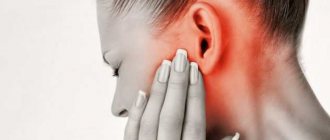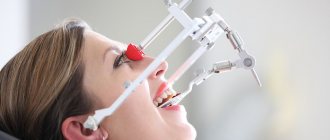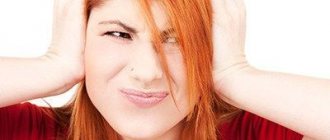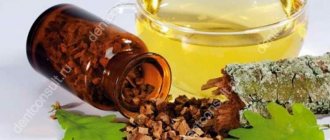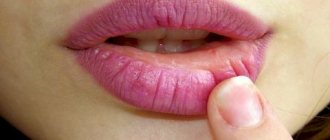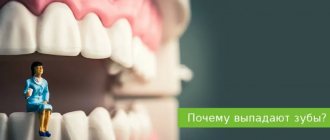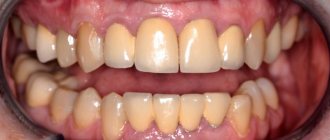Causes
Clicking in the ears, not associated with swallowing, occurs when the muscles of the hearing aid contract. This occurs with muscle spasm, as well as due to swelling of the auditory tube. Swelling accompanies infectious diseases of the ENT organs (otitis of a bacterial or fungal nature, sinusitis, pharyngitis), Meniere's disease (fluid accumulation in the inner ear), habitual dislocation of the jaw. With arthritis and arthrosis of the jaw joints, patients are bothered by crunching and clicking noises due to damage to the cartilage tissue. Ear plugs lead to pronounced clicking sounds when swallowing, as the patency of the auditory tube is impaired.
Monotonous tinnitus occurs with high blood pressure. The cause may be not only chronic hypertension, but also stress, heat stroke and intoxication. Complex noises that are auditory hallucinations are often a sign of mental illness. In any case, no matter what reason the patient suspects, self-medication is not worth it. A timely visit to an otolaryngologist for diagnosis and treatment is the best solution if noise or clicking occurs.
Ringing and noise in the ears are a common manifestation of temporomandibular joint dysfunction.
A fairly common manifestation of jaw joint dysfunction is ringing, noise, maybe even whistling, rustling in the ears, as well as congestion and hearing loss. These phenomena can be either independent or occur when moving the head, shoulders, moving the tongue or even the eyes.
There are two forms of tinnitus: central origin, which is predominantly symptomatic, and sounds associated with visible vibration of the eardrum, which can be seen during examination at an appointment with an ENT doctor.
A connection was experimentally established between dysfunction of the jaw joints, when the articular heads occupy a posterior position in their articular fossae, causing increased tone of the masticatory muscles. Anatomically, the muscles of the middle ear, responsible for the production of sounds, have a common nature of innervation with the muscles of the palate and the muscles of the auditory tubes.
The neuromuscular approach to the treatment of such patients has experimentally shown that when 136 muscles are relaxed, including the muscles of the middle ear and palate using electrical myostimulation, this entire muscle group is affected. By influencing the trigeminal, accessory and vagus nerves through the skin with a small amplitude of current, the eardrums and muscles that lift the soft palate relax.
The Dental Spa clinic successfully uses the neuromuscular approach to treat patients with noise and ringing in the ears. Using the Myotronics K7 diagnostic computer system (electromyography, computed gnathography, electrosonography) and electromyostimulation of muscles innervated by three different groups of nerves for 60-90 minutes with the Myotronics J5 myomonitor, a biometric study is performed before and after muscle relaxation.
A mandibular apparatus (orthotic or Pull Forward) is manufactured, which, when worn continuously, helps restore the tone of the ear muscles, which results in a decrease or complete disappearance of noise and ringing, as well as debt in the ears.
Also, when treating such patients, it is taken into account that when the upper jaw is narrowed, the muscle that lifts the soft palate is also in increased tone. And since it connects to the muscle that strains the eardrum, this can also affect the occurrence of noise, whistling and ringing in the ears. Therefore, the Dental Spa clinic often performs expansion of the upper jaw using special invisible orthodontic devices (ALF light wire technique, FAGGA, RAGGA devices). As a result of this treatment, the upper jaw expands, which helps normalize the tone of the muscle that lifts the soft palate and reduces or, as often happens, completely eliminates noise and ringing in the ears.
Sign up for a consultation with a leading expert in the field of neuromuscular dentistry, Elena Leonidovna Vedernikova, and take the first step towards a healthy and happy life right now! Call 229-78-83
Literature:
1. Gelb H, Geld M, Wagner M, The relationship of Tinnitus to Craniocervical Mandibular Disorders. J Cranio mandi - bular Pract 2010, Vol 15, No. 2
2. Rood SR, Doyle WJ Morphology of the Tensor levi palatini, Tensor tympani and dilatator tubae muscules. Ann Otol Rinol Laryngol 1978;87:202-10
3. Rowiki T, Xakraewska J, A study of the discomalleolar ligament in the adult human. Folia Morphol 2006, Vol65, 2, pp. 121-125
Symptoms
If clicks in the ears are associated with swelling of the inner ear, then the ENT doctor will be able to objectively record them during the initial examination. Patients with inflammatory diseases of the ENT organs are also concerned about fever, congestion and pain in the ears (usually “shooting”), and possible ear discharge. With lesions of the jaw joints, patients complain of pain when chewing and a feeling of dislocation, often accompanied by an increase in temperature.
With tinnitus, against the background of high blood pressure, patients complain of weakness, headache, nausea, spots before the eyes. The skin of these patients is hyperemic, and convulsions may occur. With heatstroke, your body temperature rises, your pulse becomes rapid and weak, and your breathing becomes faster. These conditions require emergency medical attention.
Why does my jaw click?
When chewing, talking, or yawning, a clicking sound may be heard in the jaw; most often it does not cause any pain, but often causes discomfort.
Many even get used to this sound and stop paying attention to it altogether, but this only lasts until pain joins the clicking. Unfortunately, clicking in the mandibular joint is just a symptom of a disease, but the attending dentist will have to find out which one. The most common cause of clicking is the ligaments that surround the joint capsule.
Diagnostics
It is necessary to conduct a general and biochemical blood test to determine the presence of infection, a microbiological analysis of a smear from the ear and nasopharynx. An ENT doctor examines the level of hearing and the patency of the auditory tube. X-rays and MRIs can determine the presence of inflammatory diseases, lesions of joint tissue or neoplasms; An ultrasound is performed to determine the condition of the hearing organs. In case of hypertension, blood pressure and ECG measurements are required. In the absence of physiological changes leading to tinnitus, consultation with a psychotherapist is necessary.
Why does this happen?
- Muscle tone, this can occur due to excessive clenching of the jaw, for example, when playing certain sports
— Jaw dislocation and any other injury
— The presence of extensive caries in the oral cavity with tooth decay, damaged dentures, incorrectly installed fillings
- Bruxism, better known as teeth grinding
— Joint fatigue, joint subluxation
— Arthritis of the mandibular joint
Treatment
It is clear that due to various reasons for the appearance of noise, treatment methods can vary significantly in each case. If the clicking in the ears is caused by the presence of wax plug, it is removed in a hospital setting. In the presence of infection, complex antimicrobial therapy is carried out - antibacterial or antifungal drugs, antihistamines (Diazolin, Suprastin, Loratadine) and vasoconstrictors (Otrivin, Naphthyzin, Polydexa), non-steroidal anti-inflammatory drugs (Nurofen, Ibuprofen). In case of severe muscle spasm, muscle relaxants (Drotaverine, No-Shpa) are prescribed. For lesions of the jaw joints, it is recommended to take chondroprotectors (Glucosamine, Chondroitin).
The accumulation of fluid in the inner ear requires the prescription of antipsychotics (Aminazin, Triftazin) to normalize the functioning of the vestibular apparatus and diuretics (Diacarb, Veroshpiron) to reduce the level of edema. Pneumomassage of the eardrum, performed by an otolaryngologist, is also indicated. Tinnitus with hypertension requires treatment of the underlying disease. To normalize blood pressure, beta-blockers (Anaprilin, Metoprolol), sedatives (Persen, Novo-Passit), ACE inhibitors (Captopril, Lisinopril, Ceronapril), calcium blockers (Nifedipine, Manidipine), diuretics are prescribed.
If tinnitus reduces the patient’s quality of life, along with drug therapy, the use of psychological techniques may be recommended to reduce the severity of subjective perception of noise.
The reception is conducted by specialists
Kirillov Evgeniy Sergeevich
Audiologist, otoneurologist
Cost of services
Initial consultation with an audiologist
1200₽
Repeated consultation with an audiologist
1000₽
Otitis media
The middle ear communicates with the nasopharynx through the Eustachian tube, through which infection can penetrate from the upper respiratory tract due to acute respiratory viral infections, influenza, sore throat, rhinitis, sinusitis and other diseases. Children are especially often affected because their Eustachian tube is short and wide, which makes it easier for infection to enter. The process can be one- or two-way.
Symptoms of acute otitis media:
- pain in the ear from moderate to severe, pulsating in nature (pain does not depend on pulling the lobe or pressing on the ear canal);
- increased body temperature;
- possible noise in the ear, dizziness, decreased hearing acuity;
- the presence of discharge (mucous, purulent, bloody) indicates a perforation of the eardrum.
With an aggressive course of the inflammatory process and the absence of adequate therapy, otitis media is fraught with such serious complications as meningitis, sepsis, intracranial abscess formation, and deafness.
What you can do at home
Eliminating the symptoms of the disease at home can only temporarily improve the patient’s condition. For timely diagnosis, it is advisable not to delay visiting a doctor.
In situations where clicking or pain occurs unexpectedly, you can reduce the severity of the disease and improve your overall well-being with the help of traditional medicine:
- Cold . A cloth is moistened with cold water and applied to the painful area for 10 minutes. After an hour, the procedure is repeated until relief occurs. The compress is effective for inflammatory processes in the joint.
- Warm . Hot water is poured into a bottle-type container. The container is wrapped in cloth to avoid burns and applied to the joint. The procedure reduces muscle tension due to arthrosis.
- Medicinal herbs . Decoctions of fennel, calendula, oregano or burdock help relieve inflammation and reduce pain.
To reduce the chewing load, it is recommended to temporarily abandon hard and rough foods and give preference to soft foods. Opening your mouth wide is also extremely undesirable.
Soreness
Often, compression in one or two joints leads to changes in the structure of hard tissues (arthritis, arthrosis). This condition is always accompanied by pain.
The disease most often occurs as a result of infection, which over time can cause purulent melting of the bone.
Arthritis can also develop due to traumatic injury to the lower jaw. If untreated, the disease leads to joint immobility (ankylosis) after fusion of bone, cartilage and fibrous structures. The condition can only be treated surgically.
In the catarrhal and purulent stage, the primary task of the surgeon is to ensure the outflow of exudate. In this case, a sling-shaped bandage or an orthodontic structure in the form of a plate is often used.
Further treatment is based on medication, physiotherapy and exercise therapy.
In what cases is expansion of the dentition indicated and what devices are used.
In this publication we will talk about the shortening of the dentition and the correction methods used.
Here https://orto-info.ru/zubocheliustnye-anomalii/zubov/formyi/slivshiesya.html all the most important things about the treatment of fused teeth.

